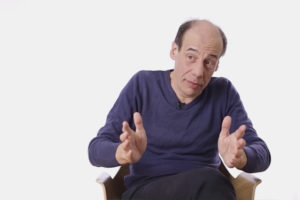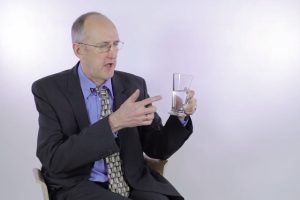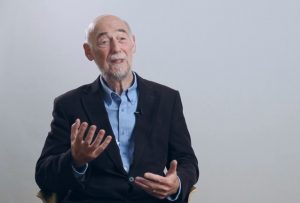End of Knowledge
Philosopher and sociologist of science Steve Fuller on the difference between ontology and epistemology, trans...
How can something be both true and false at the same time? What are dialetheic solutions? How do classical and non-classical logic differ? These and other questions are answered by Professor Emeritus of History and Philosophy of Logic in the Arché Research Centre for Logic, Language, Metaphysics and Epistemology, Stephen Read.
So I want to talk about dialetheic solutions to the Liar paradox. First of all, I need to tell you about the Liar paradox and then I need to explain this funny word ‘dialetheic’ which has been invented recently. So the Liar paradox is the paradox that arises when someone tries to say ‘I’m lying in this very utterance’ or ‘This utterance is false’. It seems rather strange, and why someone might even want to do this? But if they do, then it’s going to undermine our theory of truth or so it would seem. The argument goes like this: supposing what I say is true when I say that what I say is false. Then if it’s true, then surely that’s how things are and I’ve said that it’s false, so if it’s true, it’s false. But that means, assuming it’s true, it’s both true and false; surely nothing could be both true and false. So the assumption must be wrong: it can’t be true, it must be false. However, if we conclude that what I was saying was false, I was actually saying that what I was saying was false, then that’s how things are, so I must have been saying something true. So it seems we have an easy proof that what I’m saying now is both true and false. That’s a contradiction. It seems that nothing can be both true and false, everything is either true or false. One of those principles is called ‘the law of bivalence’: there are two truth values, and every sentence has one or other truth value.
So you might wonder: why the philosophers emphasized the law of non-contradiction, what’s so bad about contradictions? Well, there’s an argument that goes back a long way in the history of philosophy that contradictions are a very bad thing, that if we admitted contradictions into our theory, we could admit anything into our theory. So take the proposition we’ve just take, suppose we admitted that this sentence I came out with was both true and not true: then the particular it’s true. But if it’s true, then either it’s true or the moon is made of green cheese. But we’ve also conceded that it’s not true, so ‘either it’s true or the moon is made of green cheese’ and ‘it’s not true’, well, if it’s either one thing or the other and it can’t be the first one, it must be the second one. So if it’s not true, then the moon must be made of green cheese.
So if I admit that the sentence I uttered was both true and not true, I also seem to be committed to say that the moon is made of green cheese and any other proposition you come up with.
The principle right at the end there that I used, ‘Either this sentence is true or the moon is made of green cheese and it’s not true, therefore the moon may be made of green cheese’, that generalizes to the general form ‘either P or Q and not P therefore Q’, that’s a standard principle of logic which is called ‘disjunctive syllogism’: you’re moving from a disjunction. And another premise to the conclusion from the denial of one of the disjuncts to the other disjunct as a conclusion of disjunctive syllogism.
A number of people have tried to give a solution to the Liar paradox by embracing contradictions but without being committed to any conclusion whatsoever. That’s where the word ‘dialetheic’ comes in: a dialetheia is any sentence which is both true and not true; ‘dialetheia’ from the Greek means ‘two truth values’: it’s got both true and not true.
So we’re looking to see, could we embrace the dialetheic solutions to the Liar paradox but without this further implication that we would then be committed to any conclusion whatsoever? The way to do it, they say, is to reject disjunctive syllogism, reject disjunctive syllogism as a means of argument.
We can see how they’re going to do it in a way because if they think that propositions can have both true values, they can be both true and not true, then we can see that the premises of the disjunctive syllogism argument are true but the conclusion is false. And an inference that has true premises and a false conclusion is obviously not a principle that we want to have in our logic. So if we take ‘P or Q and not P’, now suppose P is both true and false; then if P is both true and false then ‘P or Q’ is both true and false whatever Q is. But if P is both true and false, then ‘not P’ is also both true and false, so ‘P or Q’ and ‘not P’ are both true and false but if that’s true and the conclusion Q in general ‘the moon is made of green cheese’ is false, so if we accepted the principle of disjunctive syllogism we could be committed to moving from true premises to a false conclusion.
And there’s a funny sense in which the premises are true, because they’re not just true, they’re also false, but the point is you’re moving from truth to false and that’s a bad move to make in logic. So now it looks as if we’ve got a viable solution to the Liar paradox if we’re willing to revise our logic, go for what’s called a non-classical logic in which we reject the principle of disjunctive syllogism.
But hang on; that was a sentence we started with! The sentence was ‘if the sentence is true, then the moon is made of green cheese’, and we’ve proved that if the sentence is true then moon is made of green cheese. So the sentence is true, so just looking at this sentence ‘if the sense is true then the moon is made of green cheese’ we’ve proved that it’s true. So it’s true but it’s antecedent was ‘the sentence is true’, so we again got a true sentence and a true conditional ‘if the sentence is true then the moon is made of green cheese’ with a true antecedent, so by modus ponens again we can infer that moon is made of green cheese. That looks as if we’ve got there already but last time we got to ‘the moon made of green cheese’ that was on the assumption that the sentence was true, we really got rid of that assumption by saying: ‘no, we’ve proved that if the sentence is true then the moon is made of green cheese’ and so we’ve proved already that the moon is made of green cheese without using disjunctive syllogism to get there. And this looks as if it might be a problem for the dialetheic solutions.
Now what these solutions then want to do is they want then to revise the theory of the conditional. Remember, the conditional didn’t appear in disjunctive syllogism; disjunctive syllogism was a principle about disjunction and negation, not about the conditional. So now the dialectic solutions are going to have to give a theory of the conditional that doesn’t fall to Curry’s paradox. There are ways of doing that, and the way they usually do it is to look at a principle called contraction. Now this really becomes a mouthful here but in a way what we’ve shown in the paradox is something in the form ‘if the sentence is true, then if the sentence is true, then the moon is made of green cheese’, and we contracted those two assumptions of ‘if the sentence is true’ down to one occurrence, so ‘if the sentence is true, then the moon is made of green cheese’ or in general we move from ‘if P then if P then Q’ to ‘if P then Q’.
And they think that thereby that’s where the problem lies: with the conditional is to think that assuming it twice is the same as just assuming it once.
Now that may seem like angels on pinheads and drawing distinctions too far to go and a lot of people would agree with you if you do think that, but that’s the way that the non-classical solutions, the so-called dialetheic solutions go: they not only reject the principle of disjunctive syllogism ‘from either P or Q and not P to Q’ – they have to reject that, otherwise they’re committed to inferring anything from a contradiction, and they want to embrace contradictions (not too many perhaps, but certainly about the Liar paradox and other paradoxes they want to say are both true and false or both true and not true). But they’re also going to have to give a novel and revised account of conditionals, and they are usually called ‘non contractive’ solutions that means that they don’t have a theory of the conditional which doesn’t admit the principle of contraction.
So to sum up, the dialetheic solutions to the Liar paradox accept everything, there is about the theory of truth that other philosophers accept plus they add to it the basic principle that it’s possible for some things to be both true and false for there to be true contradictions. But to do that it means they have to revise logic; they find that basic principles that have been around for thousands of years doesn’t mean they’re right but logicians have embraced these principles like disjunctive syllogism and the contraction of antecedents. They have to produce a logic which doesn’t hold, which doesn’t use those principles.

Philosopher and sociologist of science Steve Fuller on the difference between ontology and epistemology, trans...

Neuroscientist Friedemann Pulvermüller on brain activation, aphasia, and action-based language therapy

Philosopher Stephen Read on non-classical logic, Curry's paradox, and modus ponens